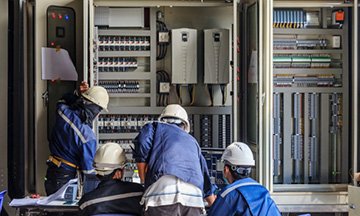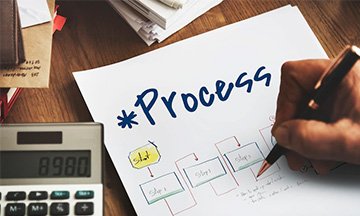PLC, HMI and SCADA Industrial Automation Training Course
| Date | Venue | Duration | Fees | |
|---|---|---|---|---|
| 27 May - 31 May, 2024 | Dubai | 5 Days | $4750 | Register |
| 05 Jun - 07 Jun, 2024 | Johannesburg | 3 Days | $4100 | Register |
| 24 Jun - 28 Jun, 2024 | Dubai | 5 Days | $4750 | Register |
| 15 Jul - 19 Jul, 2024 | Dubai | 5 Days | $4750 | Register |
| 26 Aug - 06 Sep, 2024 | Dubai | 10 Days | $8775 | Register |
| 09 Sep - 20 Sep, 2024 | Nairobi | 10 Days | $9150 | Register |
| 30 Sep - 04 Oct, 2024 | Dubai | 5 Days | $4750 | Register |
| 07 Oct - 18 Oct, 2024 | Dubai | 10 Days | $8775 | Register |
| 18 Nov - 22 Nov, 2024 | Dubai | 5 Days | $4750 | Register |
| 02 Dec - 06 Dec, 2024 | Dubai | 5 Days | $4750 | Register |
| 09 Dec - 27 Dec, 2024 | Johannesburg | 15 Days | $13500 | Register |
Course Overview
This course teaches the necessary S7 system concept, hardware configuration and parameterization, S7 software (SIMATIC TIA Portal) essentials, and an overview of programming fundamentals. Human Machine Interface (HMI) and SCADA are also included.
Numerous hands-on activities and exercises using a Totally Integrated Automation (TIA) plant model reinforce practical experience and theoretical knowledge. The TIA plant model consists of an S7-1500 automation system, SIMATIC Comfort Panel, and SCADA PLC.
Participants experience and learn TIA concepts and gain an understanding of the relationships between key industrial automation components. Upon course completion, participants are able to utilize STEP 7 tools, and techniques in order to recognize, diagnose, and remedy control system faults, reducing costly downtimes.
This Zoe training course will empower you with the consciousness of knowing the extended for the experience of SIMATIC S7 (300/400) with the possibility to work with Human Machine Interface (HMI) and SCADA and creating a new project with professional skills.
Course Objectives
Upon completing this PLC, HMI and SCADA Industrial Automation Training Course successfully, participants will be able to:
- Practise and use standard STEP 7 tools and methods
- Testing, Diagnosing, and correcting hardware & software issues in a running program
- Operate, Monitor, Control and Maintain components of a typical SIMATIC TIA system
- Establish PLC communication with multiple technologies
- Retrieve, Archive, and Download S7 programs
- Address and wire signal modules, perform start-up procedures for S7 automation system hardware and software
- Configure and parameterize S7-1500
- Hardware utilizing S7 Software tools
- Backup and document executed program changes
- Create and manage WinCC Projects
- Integrate components between WinCC and TIA Portal
- Make WinCC tags in STEP 7 symbol table
- Establish communications with the PLC
- Design a complex graphic
- Configure internal and external tags
- Define & Administer User Security
- Set and assess the WinCC Alarms and Messages
- Configure, archive and display Trends & Tables
- Configure, preview and print reports
Training Methodology
This collaborative PLC, HMI and SCADA Industrial Automation Training Course will comprise the following training methods:
- Lectures
- Seminars and Presentations
- Group Discussions
- Assignments
- Case Studies and Functional Exercises
Zoe Talent Solutions follows the ‘Do-Review-Learn-Apply’ model.
Organisational Benefits
Companies who enrol their employees to participate in this PLC, HMI and SCADA Industrial Automation Training Course can benefit in the following ways:
- Keep your company one step ahead with this all-inclusive overview of PLC-HMI and SCADA Industrial Automation
- Assist technical committees to create, publish and revise working standards relating to PLC-HMI and SCADA Industrial Automation
- Prudently study examples and case studies to illustrate the material being discoursed and ensure that the material is appropriate to the organisation represented
- Leave with an awareness and understanding of their roles and responsibilities in the workplace in relation to PLC-HMI and SCADA Industrial Automation
Personal Benefits
Individuals who participate in this PLC, HMI and SCADA Industrial Automation Training Course can gain from it in the following ways:
- Keep up with late-breaking improvements and developments in Advanced PLC Programming by learning new literature and other sources of information
- Benefit from a tailor-made academic program for technicians or equivalent workforce involved in PLC-HMI and SCADA Industrial Automation
- Get yourself trained, assessed, and certified by experts in the PLC-HMI and SCADA Industrial Automation. Provide examples of issues that they encounter during their normal working activities and get possible solutions
Who Should Attend?
PLC, HMI and SCADA Industrial Automation Training Course would be suitable for:
- Programmers
- Commissioning engineers
- Configuring engineers
- Service personnel
- Maintenance personnel
- Operators
Prerequisites
The skills and ability to work on a MS Windows PC, keyboard and mouse to include opening and closing programs, finding files, copy and paste objects /data (text, etc.). Drag and drop files, objects/data (text, etc.). Knowledge of using menus and multi-menus, manipulation of windows in a multi-window environment. Use of MS Windows Help.
SIMATIC S7 knowledge and practical experience in SCADA.
Course Outline
MODULE 1: Course Overview
- Course goals
- Course project overview
- Training equipment
- Create course project
MODULE 2: System Overview
MODULE 3: Introduction: Engineering Software “TIA Portal”
- Comparison STEP 7 Basic/ Professional
- Portal-View
- Project View
- Windows arrangement
- Online Help
- Settings: Download, Project path
MODULE 4: PLC Installation & Maintenance
- S7-1500 Hardware Components & Installation
- Remote I/O Hardware Components & Installation
- Signal Module Wiring, Removal, & Installation
MODULE 5: Device and Network
- Hardware-Editor
- Hardware-Catalog / Device-View
- Creating a Configuration
- Reading Configurations
- Network-View
- Configuring devices on the Network
MODULE 6: Tag Table
- Tag Names
- PLC-Tag / User-Parameter / System Parameter
- Introduction to Symbol Table Editor
- Local and Global symbols
- Watching Global Symbols in PLC Tag Table
- Using Excel to create Symbol Tables
MODULE 7: Hardware Commissioning
- Hardware LED Indicator Descriptions & Troubleshooting
- Clearing the PLC memory
- Testing & Troubleshooting I/O
- Calling the “Watch Table” Tool
- Monitoring and Modifying Variables
MODULE 8: Program Blocks
- S7 Block Types
- Structured programming
- Process Image Inputs/Outputs
- Cyclic Program processing
- Ladder Logic and Function Block Diagram
- Using the Block Editor
- Program Testing & Troubleshooting by operating the “Monitor Block” function
MODULE 9: Binary Operations
- S7 Block Types
- Distinct variations between “real” connected NC contacts and NO contacts and programmed symbols
- Programming basic binary logic operations
MODULE 10: Digital Operations
- Data Types
- SIMATIC Counter & Timer Functionality
- Data Blocks
- IEC Counter & Timer Functionality
MODULE 11: Introduction to HMI & SCADA
- Data Exchange between HMI and PLC
- Commissioning a Comfort Panel Project
- Networking the Comfort Panel
- Troubleshooting an HMI Network
- Creating a SIMATIC WinCC Professional project
- Configuring and aligning the connection to the SIMATIC S7 automation system
- Structuring the operator interface
- Fundamentals of designing graphic displays for human machine interfaces
- Navigating through the plant displays
- User administration
- Message representation, message logging, message configuring
- Variable logging, trend configuring, and trend plotting
- Message representation containing logging of data in the database
- Recipes
- Re-usable faceplates and centralized modification and alteration of graphic blocks
- Global Scripting & Background processing
MODULE 12: Graphics Designer
- Tools & Features for creating a graphic
- Using Object, Styles & other palettes
- Use object properties and events
- Creating a Customized Object
- Using the Object Library
MODULE 13: Making Objects Dynamic
- Direct Connect Interface
- Dynamic Dialog Interface
- Object C/VBS Scripting
- Global Actions
- Script Threading Model
MODULE 14: Advanced Functionality
- Tag Prefix / Popup windows
- Creating Faceplates
MODULE 15: User Administration & Security
- Groups & Users
- Log on & Log off
- OS Security
MODULE 16: Archiving & Trending
- Archive configuration
- WinCC Online Trend Control
- WinCC Online Table Control
MODULE 17: Archive Management
- Configuring and arranging archive and backup management for Alarms and Trending











